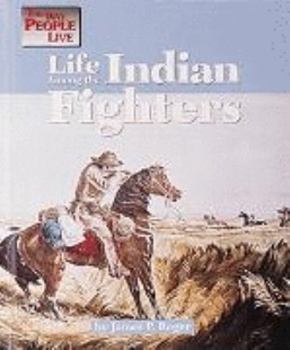Life Among the Indian Fighters
(Part of the The Way People Live Series)
The Indian fighters helped to push the Indian steadily westward, ultimately condemning their remaining population to reservations. Sometimes friends of the Indians, the Indian fighters betrayed these... This description may be from another edition of this product.
Format:Hardcover
Language:English
ISBN:1560063491
ISBN13:9781560063490
Release Date:June 1997
Publisher:Lucent Books
Length:128 Pages
Weight:0.90 lbs.
Dimensions:0.5" x 7.7" x 9.2"
Age Range:10 to 13 years
Grade Range:Grades 5 to 8
Customer Reviews
1 rating
More history than most, but a good beginning
Published by Thriftbooks.com User , 17 years ago
Author Reger, according to his biography on the last page of this volume, descends from pioneers who experienced several "brushes" with Indians in the West Virginia region, including one who "lived...as a slave 'wife'" for several years among an unspecified tribe in Ohio. This may account for his rather aggressive political incorrectness (as witnessed by the fact that he never uses the term "Native American," which, of course, was completely unknown at the time of which he writes). The chief flaw in the book is that it isn't always easy to figure out whether he's referring to the early Eastern woodsmen or the later "mountain men." Apart from that, he does include (as authors in this series almost always seem to) several omissions and errors of fact; he speaks of the "beatings [and] general disrespect" that the third or fourth wife of an Indian brave was likely to suffer, and accepts as wholly accurate trapper Jim Beckwourth's assertion that he not only once tomahawked a Blackfoot wife nearly to death, but was actually supported in his action by her father, who advised his warriors that they should kill wives who failed to obey them. (Beckwourth himself admitted that he stretched the truth more than once, as when he lied to an aged Crow chief and his wife to convince them that he was their long-lost son and so get himself accepted into the tribe; and my 40-odd years of study convince me that among the Plains peoples, as among most other North American tribes, women had a good deal of status and were very seldom abused--and when they were, they had the option of divorce, if their own families didn't avenge them.) He completely ignores the many instances of white "captives," of all ages and both sexes (including several who had been noted as Indian fighters before their capture), who grew so attached to the Indians who adopted them that they refused to be reassimilated even after their return was mandated by treaty, hiding out in the woods till the enforcers gave up and went home, running away from their white families to get back to the new Indian ones, or even visiting their former homes in an effort to persuade others to join them. He speaks of "one hundred years of nearly constant strife" between whites and Blackfeet, dating from Lewis & Clark's first encounter with them in 1806 (in fact, the tribe was mostly pacified, owing in part to epidemics, by the late 1860's), suggests that black bears are innately aggressive (actually they're quite shy, and prefer to run from a human rather than attacking him, unless you meet with a female trying to protect her cub), and takes as gospel the story that a grizzly (admittedly a rather more perilous species of b'ar) "attempted to crush [a trapper] in a deadly embrace" (the "bear hug" is in fact a fabrication: bears attack by biting or by blows of their forepaws). He speaks of the strong odor of his subjects as if it were a constant, when in fact those who lived for long periods among the Indians (es





